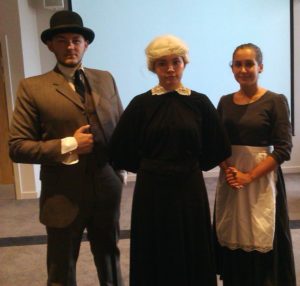*Update: please see the Harewood House category for other posts about this project.*
Over the past few weeks of our collaborative project with Harewood House I have been working both in Harewood’s archives with Collections Assistant Rebecca Burton, and with our three actors to devise and rehearse a script for our performance.
In terms of research, we have been able to answer several questions about the history of Harewood’s electrification, such as being able to confirm that the initial installation used hydroelectric power generated by a turbine, with an oil engine back-up, and that the House definitely did have gas lighting below stairs before the installation of electricity, but this was then removed – this had been a subject of some speculation. This will feed into our new displays and interpretation, and also into the performance. We have also been selecting new objects and writing the new interpretation for the lighting cabinet, with aim of launching this on the day of the Harewood workshop, Sunday 11 August.
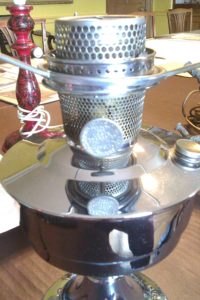
This workshop will act as the focal point of a day in which we showcase our research in a number of ways. Firstly, Rebecca will give a short collections ‘discovery‘ talk about project to visitors, and point out that we have put together two new displays on the history of electricity at Harewood: one below stairs as an exhibit about the different lighting technologies used in the House over the centuries, and the other on the State Floor in Princess Mary’s Dressing Room, which was electrified as it was built according to her specifications. Prior to the workshop itself at 2pm, the actors will also move around the house and grounds in costume, interacting with visitors and drawing attention to the workshop. Finally, a craft activity making cup-and-string telephones will go on in the House all day.
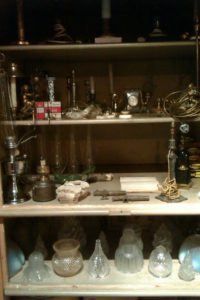
As far as the workshop itself is concerned, we have decided to set the performance, which is about 10 minutes long, in the 1930s, when the 6th Earl and Princess Mary modernised the house further, rather than the original period of its electrification, 1901. Instead, one of the characters, the housekeeper at Harewood, will be old enough to remember the original installation and discuss it in a soliloquy to the audience. The other two characters, Betty, a young maid nervous about electricity because her mother, who was also a maid 30 years ago, warned her about it, and Mr Symes, an electrical engineer visiting Harewood to survey the alterations being undertaken and offer advice, will also talk to the audience about their lives and points of view as well as conversing with the other characters.
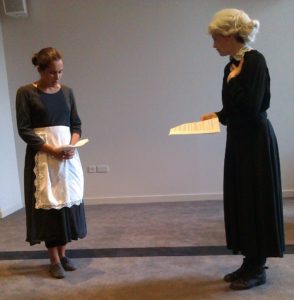
Whilst the housekeeper’s and the maid’s costumes came from the costume store run by the School of Performance and Cultural Industries at the University – including an excellent white wig – we hired the electrical engineer’s costume from the West Yorkshire Playhouse, which entailed a visit to their costume department to sort through their large collection of period clothing. The results, as depicted, were brilliant.
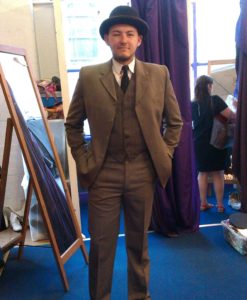
After the performance, I will run an object handling session for participants, demonstrating some basic guidelines for examining museum artefacts. We will use objects from the University‘s Museum of the History of Science, Technology and Medicine, but these are not appropriate for handling sessions due to their rarity and fragility, so I will present and discuss these objects to talk about the early history of electricity supply – in particular how early installations at country houses needed to be self-contained, and how important it was to be able to measure how much electricity was being used.
After this, we will give workshop participants the opportunity to handle for themselves some old 1920s-40s domestic electrical appliances borrowed from Artemis, an object loan service run by Leeds City Council. Artemis has an extensive handling collection which it provides for schools and museums, and these objects can be used to enhance lessons or workshop sessions such as ours.
To find out how our workshops go you can of course follow us on Twitter (@EtCHproject), and now we’re on Instagram as well: follow us, ‘electricalheritage‘!
